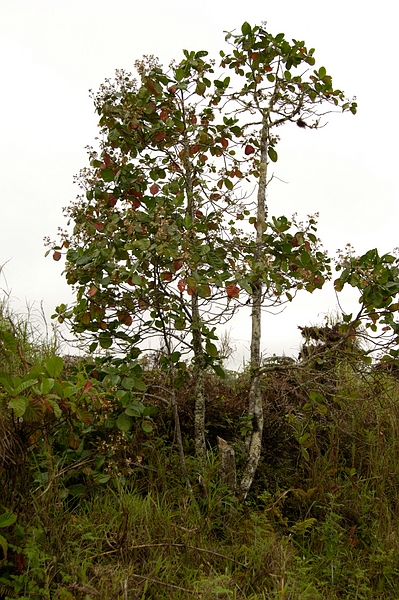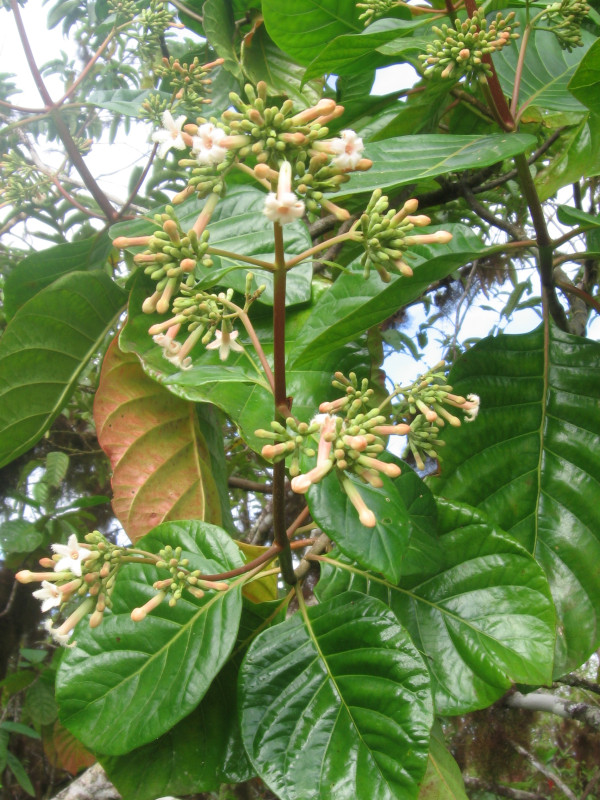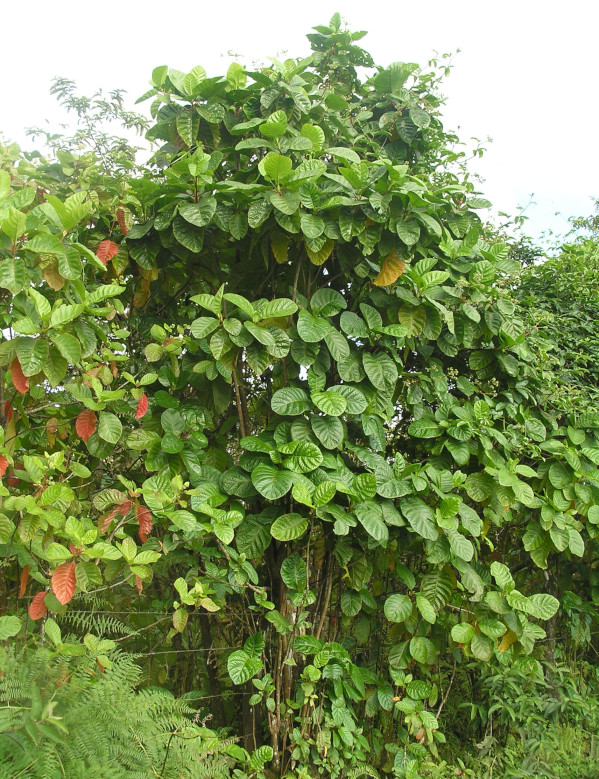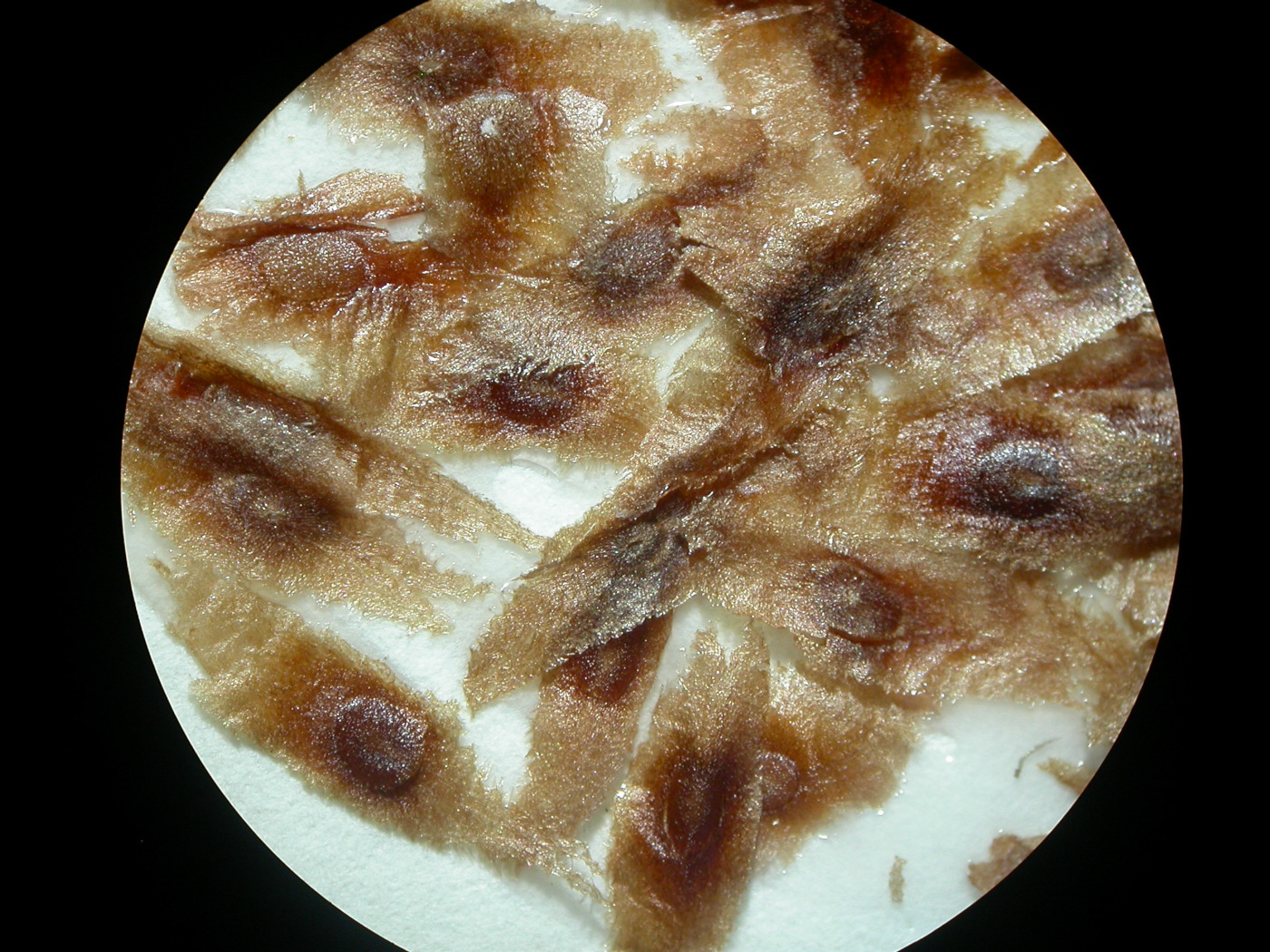Galapagos Species Database
The Galapagos Species Database shares the information about the species from our Natural History Collections.
Cinchona pubescens
Cascarilla, Quinina, Quina, Quinine, Red Quinine Tree







Evergreen tree up to 15 m in height with broad, opposite leaves. Flowers are fragrant, white or pink and arranged in clusters. Fruits are cylindrical capsules up to 4 cm long that contain numerous small, light and winged seeds which are dispersed by wind.
Usually produces a main trunk but also often develops several trunks a short distance away, which emerge by suckering from underground stems. This way, tree takes on a multi-stemmed growth form, with the individual stems still connected. Leaves turn bright red when old.
Domain
Eukaryota
Kingdom
Plantae
Phylum
Magnoliophyta
Class
Magnoliopsida (= Dicotyledoneae)
Order
Gentianales
Family
Rubiaceae
Genus
Cinchona
Species
pubescens
Taxon category: Accepted
Syn.: Cinchona succirubra Pav. ex Klotzsch fide Royal Botanic Gardens, Kew & Missouri Botanical Garden (2010)
Taxon origin: Introduced - established
Preference for an altitude zone in Galapagos: Humid zone
Habitat preferences: Native to neotropical forests, prefers humid and warm upland sites. Shade-tolerant and can tolerate a wide range of ecological conditions, including drought.
Substrate or host preferences: Often grows in steep gorges that are difficult to access and in disturbed habitats in its native range in Ecuador, as well as in Hawaii and Galápagos. Soils in Ecuador are volcanic and rich in organic matter, nitrogen and phosphorus, warm and slightly acid.
Trophic role: Primary producer
Persistence mechanisms: Seeds
Reproduction mode: Both sexual and asexual
Reproductive biology: Youngest seed producing trees found in Galápagos were 2 years old, 1.8 m tall and with a DBH of 1.5 cm. Germinates well in dense vegetation and spreads rapidly by light windborne seeds and also vegetatively by suckering from stems.
Growth form: Trees
Distribution origin: Natural distribution is from Costa Rica to Bolivia at altitudes between 300 and 3300 m.
Natural enemies: Fungi species associated with C. pubescens: Elsinoe cinchonae Jenkins, Phytophthora cinnamomi Rands, Prillieuxina cinchonae J.A. Stev. (Systematic Mycology and Microbiology Laboratory).
Associated species in Galapagos: Mainly epiphytic ferns, like Phlebodium pseudoaureum and Polypodium tridens
Economic Use: Quinine extracted from the bark was historically used as an antimalarial drug and quinidine is still used today as an antiarrhythmic drug. Wood is used for construction.
Mode of introduction: Intentional
Introduction Pathway: Intentional
Subpathway: Agriculture/Horticulture
Introduced status: Naturalized
Invasive status: Invasive
Impact in Galapagos: Started spreading about 30 years after introduction in the 1940s. Has invaded farmland and all vegetation zones in the highlands of the National Park: Scalesia-, Miconia- and Fern-Sedge zones. Transformed formerly treeless vegetation zone into near-forests. Reduces cover and diversity of most other plant species, especially of endemic species, like the shrub Miconia robinsoniana, the herbs Justicia galapagana, Pilea baurii and the tree fern Cyathea weatherbyana. Dense stands of quinine reduce light by 87 % and increase nutrient availability in the soil.
Control History in Galapagos: Successful control methods now applied by the Galapagos National Park Service are: manual control by uprooting of trees and hand-pulling of smaller plants. Chemical control by ‘hack and squirt’ technique, which consists of applying a mixture of picloram and metsulfuron to connecting machete cuts around the circumference of the tree trunks. Studies on the impacts of these measures showed that despite an initial decline in species cover, native plants recover again and cover as well as species diversity increases 2 years after control took place. However, it is unclear whether this recovery is transient, since long-term data is lacking. Control actions probably also facilitated the establishment of other introduced species and seemed to be assisting the spread of the highly invasive blackberry (Rubus niveus) in the highlands of Santa Cruz Island. In addition, constant hand-pulling of germinated seedlings would be necessary to assure control success in the long run.
Control methods elsewhere: Not known
Known Pest elsewhere: Hawaii, Tahiti, Java oeste
Year of first record: 1971
Year of introduction: 1946
Map of specimen collection localities or observation records for this species in our collections database.
Distribution: 11,000 ha on Santa Cruz.
- Hamann, O. (1974) Contributions to the Flora and Vegetation of the Galapagos Islands: III. Five new Floristic Records. Bot. Notiser 127: 309-316.
- Porter, D.M. (1983) Vascular Plants of the Galapagos: Origins and Dispersal. In: Bowman, R.I., Berson, M. & Leviton, A.E. (eds.): Patterns of evolution in Galápagos organisms. Pacific Division, AAAS, San Francisco, California, p. 33-96.
- Schofield, E.K. (1984) Plants of the Galapagos Islands. Field Guide and Travel Journal. Universe Books, New York, 159 pp.
- Hamann, O. (1984) Changes and threats to the vegetation. In: Perry, R. (ed.) Key Environments: Galapagos. Pergamon Press, Oxford, p. 115-131.
- Jaramillo, P. (1998) Distribución Espacial de la Vegetación Vascular y Dispersión de Especies Introducidas dentro del Parque Nacional Galápagos. Tesis de Doctorado en Biología, Universidad Central del Ecuador. Especialización ECOLOGIA DE POBLACIONES.
- Moll, E. (1990) A Report on the Distribution of Introduced Plants on Santa Cruz Island, Galapagos Charles Darwin Reaearch Station, unpublished.
- Royal Botanic Gardens, Kew Missouri Botanical Garden (eds.) (2013) The Plant List, Version 1.1. Published on the Internet; http://www.theplantlist.org/ (accessed 1st January).
- Itow, S. (1997) List of Plant Specimens collected in the Galápagos Islands, Ecuador. Bulletin of the Faculty of Liberal Arts, Nagasaki University, Natural Science, 38 (1): 53-144.
- Jaramillo, P. (1999) Impacto de las Actividades Humanas sobre las comunidades de plantas nativas en el Parque Nacional Galápagos. Informe Galápagos, 50-55 (Eds P. Ospina and E. Muñóz). Quito-Ecuador: Fundación Natura y el Fondo Mundial para la Naturaleza (WWF).
- Jaramillo, P. (1999) Impact of Human Activities on the Native Plant Life in Galapagos National Park. Galapagos Report, 50-55 (Eds P. Ospina and E. Muñóz.). Quito-Ecuador: Fundación Natura and World Wildlife Fund (WWF).
- Jaramillo, P. (2000) Plantas amenazadas y medidas de conservación en varias islas del archipiélago. Informe Galápagos, 70-76 (Eds P. Ospina and E. Muñoz.). Quito-Ecuador: Fundación Natura y el Fondo Mundial para la Naturaleza (WWF).
- Tapia, W. Jaramillo, P. (1999) Las especies introducidas agresivas en las islas Galápagos y medidas tomadas para su control. El Parquero. 40 años del Parque Nacional Galápagos, 14-16.
- Mauchamp, A. Atkinson, R. (2008-2009) Pérdida de hábitat rápida, reciente e irreversible:Los Bosques de Scalesia en las Islas Galápagos. Fundación Charles Darwin Research Station
- Guézou, A. Trueman, M., Buddenhagen, E., Chamorro, S., Guerrero, A.M., Pozo, P., Atkinson, R. (2010) An extensive Alien Plan Inventory from the Inhabited Areas of Galapagos Plos One/ www.plosone.org. Volume 5/ Issue 4/e10276
- Jäger, H. Tye, A., Kowarik, I. (2007) Tree invasion in naturally treeless environments: Impacts of quinine (Cinchona pubescens) trees on native vegetation in Galápagos Institute of Ecology, Department of Ecosystem Sciences and Plant Ecology, Technical University Berlin, Rothenburgstr. 12, 12165 Berlin, Germany.
- Gardener, M. Atkinson, R., Rueda, D. & Hobbs, R. (2010) Optimizando la restauración de la degradada parte alta de Galápagos: un marco conceptual. Informe Galápagos 2009-2010.
- Itow, S. (2003) Zonation pattern, succession process and invasion by aliens in species-poor insular vegetation of the Galapagos Islands. Global Environmental Research, 7:39-58.
- Jäger, H. Kowarik, I., Tye, A. (2009) Destruction without extinction: long-term impacts of an invasive tree species on Galápagos highland vegetation. Journal of Ecology 97, 1252–1263.
- Andersson, L. (1998) A revision of the Genus Cinchona (Rubiaceae-Cinchoneae). Memoirs of the New York Bot. Garden, Volume 80.
- Acosta Solís, M. (1945) Hábitat y distribución de las Cinchonas en el Ecuador. Flora, Revista al Servicio de las Ciencias Naturales y Biológicas, Inst. Ecuatoriano de Ciencias Naturales 6, 15–16, 9–18.
- Buddenhagen, C. E. Rentería, J. L., Gardener, M.; Wilkinson, S. R., Soria, M., Yánez, P.; Tye, A., Valle, R. (2004) The control of a highly invasive tree Cinchona pubescens in Galapagos. Weed Technology 18, 1194–1202.
- Jäger, H. Kowarik, I., Tye, A. (2009) Destruction without extinction: long-term impacts of an invasive tree species on Galápagos highland vegetation. Journal of Ecology 97, 1252–1263.
- Jäger, H. Kowarik, I. (2010) Resilience of native plant community following manual control of invasive Cinchona pubescens in Galápagos. Restoration Ecology 18, 103–112.
- Jäger, H. (2011) Cinchona pubescens In: Roloff, A., Weisgerber, H., Lang, U., Stimm, B. (Eds.): Enzyklopädie der Holzgewächse, Wiley-VCH, Weinheim, 58. Erg.Lfg. 06/11, 14 pp.
- Junaedi, D.I. Mutaqien, Z. (2010) Diversity of tree communities in Mount Patuha region, West Java. Biodiversitas 11 (2): 75-81
- Shimizu, Y. (1997) Competitive relationships between tree species of Scalesia (S. pedunculata, S. cordata, S. microcephala) and introduced plants (Cinchona succirubra, Psidium guajava, Lantana camara) with reference to regeneration mechanism of Scalesia forests in the Galápagos Islands. Repr. from Regional Views 11, 23–172. Inst. for Applied Geography, Komazawa Univ., Tokyo.
- Gardener, M. R. A. Tye and S.R. Wilkinson (1999) Control of Introduced plants in the Galapagos Islands. Twelfth Australian Weeds Conference, Tasmania Weed Society. Pp 396-400.
- Tye, A. M. C. Soria and M. R. Gardener (2002) A strategy for Galapagos weeds. In Veitch, C. R. and Clout, M. N. (eds.) Turning the tide: the eradication of native species. IUCN SSC Invasive Species Specialist Group. IUCN, Gland, Switzerland and Cambridge, UK. IUCN SSC Invasive Species Specialist Group. IUCN, Gland, Switzerland and Cambridge, UK.
- Bustamante, R. Herrera, I., Hulme, P., Núñez, M., Pauchard, A. & Simberloff, D. (2016) Revista Bioinvasiones. Revista de invasiones biológicas de América Latina y el Caribe. Bustamante, R., Herrera, I., Hulme, P., Núñez, M., Pauchard, A. & Simberloff, D. (2016). Revista Bioinvasiones. Revista de invasiones biológicas de América Latina y el Caribe. Volumen 1


Dispersal propagule: Varius
Seeds and stem sprouts.